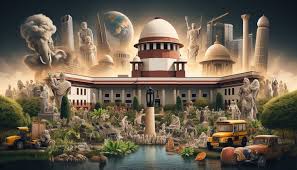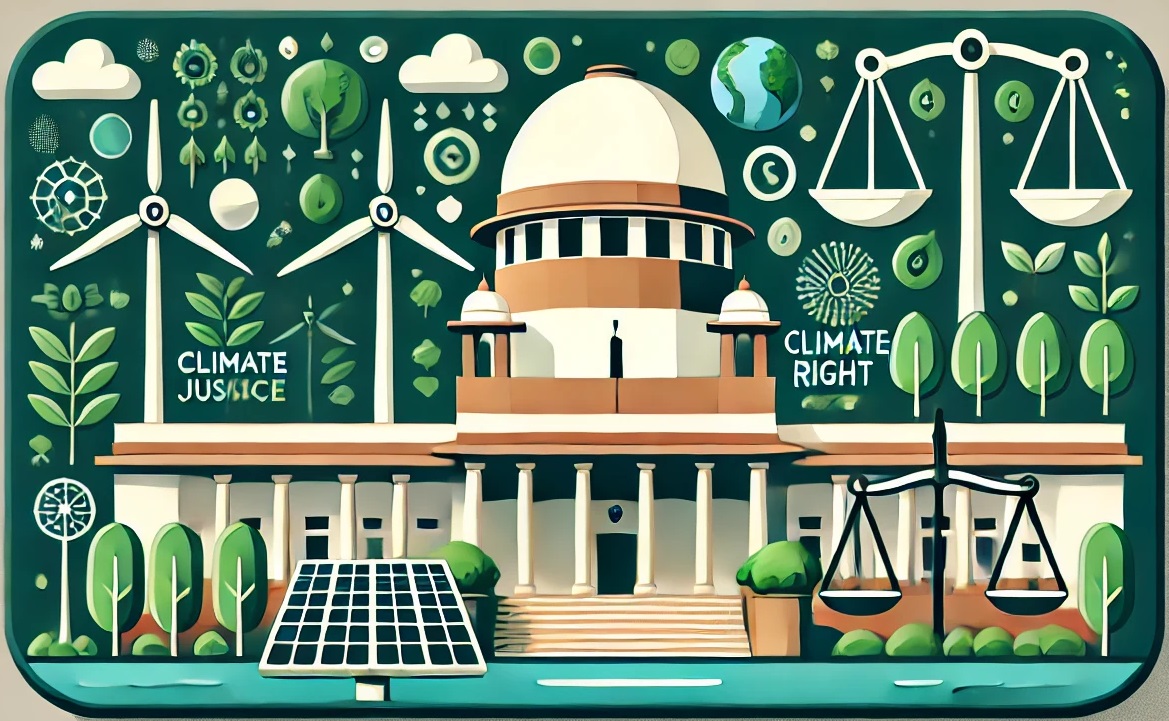Syllabus : GS 2 - Indian Polity – Judiciary
Practice question for mains :
The Supreme Court's Ranjitsinh judgement introduced a constitutional 'climate right' under Articles 21 and 14. Discuss its significance for India's climate governance and the need for comprehensive climate legislation.
Context : The Supreme Court of India’s landmark Ranjitsinh judgement introduces a constitutional ‘climate right’ under Articles 21 and 14, emphasising protection from adverse climate effects. It urges potential climate legislation to integrate mitigation and adaptation strategies, tailored to India’s federal structure and developmental needs, to advance sustainable development goals.
The recent judgment in M.K. Ranjitsinh and Ors. vs Union of India & Ors by the Supreme Court of India has introduced a significant development in India's climate change jurisprudence. The court recognized a constitutional right to be free from the adverse effects of climate change, linking it to the right to life and the right to equality. This judgment has significant implications for climate governance in India.

Introduction to Ranjitsinh Judgment
- The Supreme Court of India has expanded India’s climate change jurisprudence by recognizing a constitutional right to ‘be free from the adverse effects of climate change’.
- This right is grounded in Article 21 (Right to Life) and Article 14 (Right to Equality) of the Constitution.
Introduction to the Issue
- The case involved the construction of electricity transmission lines through the habitat of the endangered Great Indian Bustard.
- Government argued for modifying habitat protection orders to enhance renewable energy infrastructure.
Significance of the Judgment
- The court prioritised renewable energy development but introduced a groundbreaking ‘climate right’, empowering citizens to demand protection from climate impacts.
- This opens avenues for climate litigation against government actions detrimental to this right.
Debate over Climate Adaptation and Mitigation
- While the judgment prioritizes renewable energy development, it raises questions about balancing large-scale clean energy projects with local environmental resilience and climate adaptation.
Potential for Climate Legislation
- Need for Climate Legislation
o India lacks comprehensive ‘umbrella legislation’ addressing climate change despite judicial recognition.
o Such legislation can provide a systematic framework across sectors and regions, unlike piecemeal judicial directives.
- Advantages of Legislation
o Framework legislation can set a national vision for climate action, establish necessary institutions, and streamline governance processes.
o It can integrate climate considerations into urban planning, agriculture, water management, and energy sectors, promoting resilience and low-carbon growth.
- Tailoring Legislation to Indian Context
o Legislation should not blindly replicate models from other countries but should address India’s unique vulnerabilities and developmental needs.
o It must balance mitigation efforts with robust adaptation strategies tailored to local conditions.
Types of Climate Legislation
- Regulatory vs. Enabling Legislation
o Regulatory laws, like those in the UK, focus narrowly on emissions control, whereas enabling laws, as seen in Kenya, stimulate holistic development aligned with climate resilience.
o An enabling law in India would promote procedural frameworks for transparency, public participation, and target-setting across diverse ministries and sectors.
o The law should facilitate knowledge-sharing, ensure transparency in decision-making, and encourage expert consultation.
o It should include mechanisms for setting and revising climate targets, and reporting on progress, ensuring accountability.
Federalism and Local Governance
- Adaptation to Federal Structure
o Given India’s federal governance, climate legislation must strike a balance between national coherence and empowering state and local governments.
o It should decentralise decision-making while providing resources and support for effective climate action at sub-national levels.
o Beyond government, businesses, civil society, and local communities must be integral to climate decision-making.
o The law should enable diverse stakeholders to contribute knowledge and perspectives, enhancing the effectiveness of climate initiatives.
Path Forward
- An effective Indian climate law should blend regulatory and enabling approaches, prioritising both mitigation and adaptation.
- It must be tailored to India’s federal structure, promoting coherent national action while empowering local entities.
- By fostering inclusive governance and addressing sector-specific challenges, such legislation can fulfil the promise of the Ranjitsinh judgement and advance India’s climate resilience and sustainable development goals.
Related Concepts/Important information :
How the Supreme Court of India Has Broadened the Scope of Article 21:
Article 21 of the Indian Constitution guarantees the Right to Life and Personal Liberty, stating: "No person shall be deprived of his life or personal liberty except according to procedure established by law." Over time, the Supreme Court has significantly broadened the scope of this fundamental right through various landmark judgments. The Court has interpreted "life" to mean more than mere survival, expanding it to include a wide range of rights that are crucial to living with dignity, freedom, and security.
Key Judicial Interpretations of Article 21:
- Maneka Gandhi vs. Union of India (1978): The turning point in the interpretation of Article 21 came with this case. The Court ruled that "procedure established by law" must be just, fair, and reasonable, thus widening the scope of Article 21. This judgment ensured that personal liberty cannot be curtailed arbitrarily, and procedural fairness became a key constitutional safeguard.
- Francis Coralie Mullin vs. Union Territory of Delhi (1981): The Supreme Court held that the right to life under Article 21 does not merely imply animal existence or survival but includes the right to live with dignity. This laid the foundation for recognizing several socio-economic rights under Article 21.
- Olga Tellis vs. Bombay Municipal Corporation (1985): The Court ruled that the right to livelihood is part of the right to life. In this case, pavement dwellers challenged their eviction, and the Court held that forcing people to leave their homes without alternative means of livelihood violated Article 21.
- Vishaka vs. State of Rajasthan (1997): In this case, the Court expanded the scope of Article 21 to include the right to a safe working environment, especially for women, leading to the formulation of guidelines on sexual harassment in the workplace.
- Environmental Protection: The Court, through judgments like Subhash Kumar vs. State of Bihar (1991), expanded the scope of Article 21 to include the Right to a Healthy Environment, holding that the right to life is violated by pollution or environmental degradation.
- Right to Education: In Unnikrishnan J.P. vs. State of Andhra Pradesh (1993), the Court interpreted the right to life to include the Right to Education, leading to the introduction of Article 21A through a constitutional amendment, making free and compulsory education a fundamental right for children.
- Right to Privacy: In the landmark case of K.S. Puttaswamy vs. Union of India (2017), the Supreme Court declared that the right to privacy is an intrinsic part of Article 21. This judgment significantly expanded the scope of personal liberty and autonomy, protecting individuals from state intrusion into their private lives.
- Right to Health: The Supreme Court, through several judgments (e.g., Paschim Banga Khet Mazdoor Samity vs. State of West Bengal), has declared that the Right to Health is an integral part of Article 21, obligating the state to provide healthcare services to its citizens.
- Right to Die with Dignity: In Common Cause vs. Union of India (2018), the Supreme Court recognized the Right to Die with Dignity, legalizing passive euthanasia and allowing living wills, thus expanding the interpretation of the right to life under Article 21.
Importance :
- Dignity of Life: The broad interpretation of Article 21 ensures that citizens not only have the right to live but to live with dignity. It recognizes fundamental needs like livelihood, shelter, education, health, and environmental protection as essential for a dignified existence.
- Judicial Activism and Protection Against Arbitrary State Action: By requiring laws to be fair and just, the Supreme Court has provided a vital safeguard against arbitrary or excessive state action. Citizens are now protected from unjust deprivation of life or liberty, ensuring that state laws and actions must meet constitutional standards of fairness.
- Empowerment Through Rights: Article 21 has empowered citizens by ensuring access to a variety of fundamental rights—privacy, health, education, livelihood, and a clean environment. This broad interpretation of rights allows individuals to challenge government actions that may violate their right to a dignified existence.
- Social Justice: Through judgments related to health, education, and environmental rights, Article 21 has ensured that vulnerable sections of society, including the poor and marginalized, have greater access to essential services, thus promoting social justice.
Relevance of Article 21 Today:
- Foundation for Expanding Fundamental Rights: Article 21 has become the cornerstone of fundamental rights jurisprudence in India. It serves as the basis for several socio-economic and civil liberties, acting as a broad platform from which other rights (education, privacy, health, environment) are derived.
- Balancing Technology and Privacy: With the rise of digital technologies, the right to privacy has become increasingly relevant. The Supreme Court's interpretation of Article 21 in the Puttaswamy case helps protect citizens' privacy against excessive government surveillance or data misuse in the digital age.
- Health and Environment as Rights: In a time when public health crises (like pandemics) and environmental challenges (like climate change) are critical issues, Article 21 plays a central role in ensuring that citizens' right to health and a clean environment is upheld.
- Dynamic Role of the Judiciary: The broad interpretation of Article 21 has enabled the judiciary to play a proactive role in securing justice for individuals. By continuously expanding its scope, the judiciary has acted as a protector of civil liberties, ensuring that the state remains accountable to the fundamental rights of its citizens.
In conclusion, the Supreme Court of India has transformed Article 21 from a narrow guarantee of life and liberty into a robust source of fundamental rights that directly impact citizens’ lives. This expansion has made Article 21 one of the most powerful tools for protecting and enhancing the dignity, freedom, and security of the people of India. Its relevance continues to grow in a rapidly changing society, ensuring that the Constitution remains a living document that adapts to new challenges.


